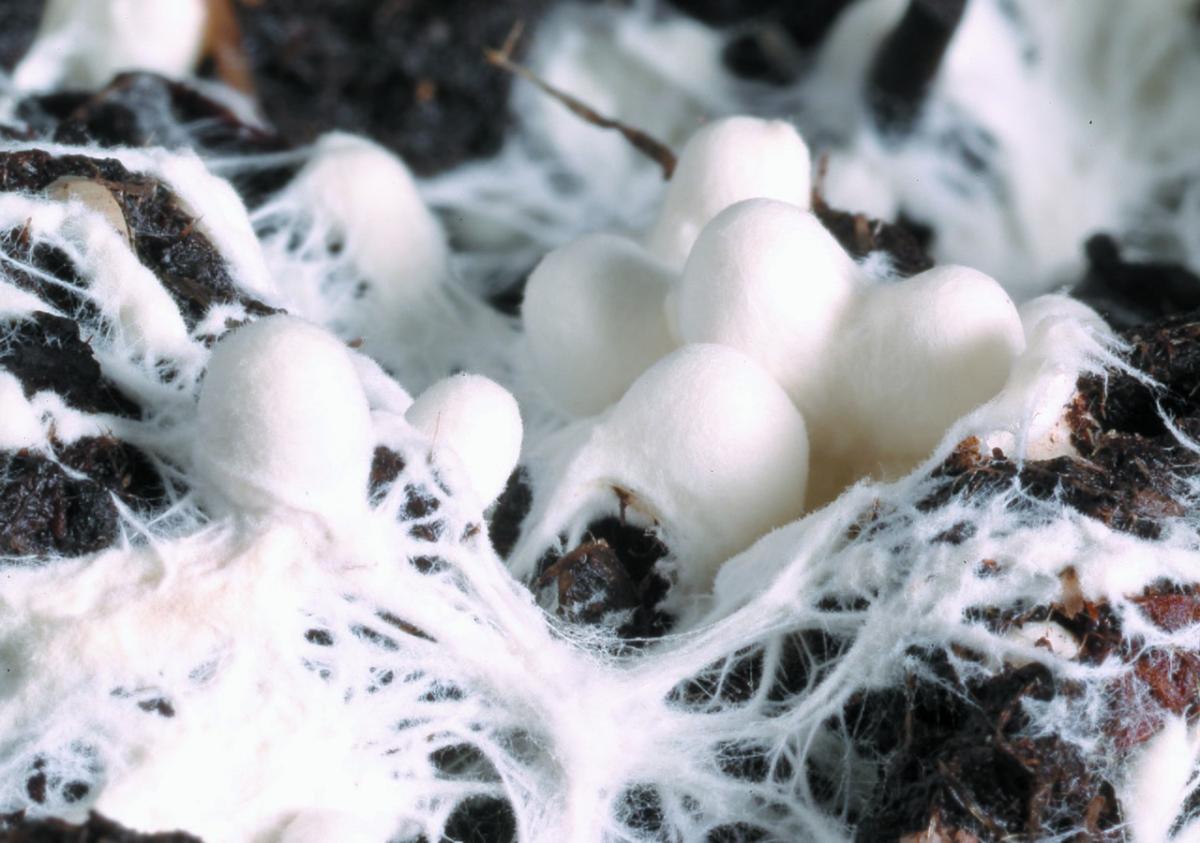

Image – Wikimedia / Pradejoniensis
If you’ve ever had fungal plants you may have seen a kind of white fibers or “threads”either in the trunk, roots and / or in the ground. This is known as mycelium, and it is an indicator that the infection has advanced a lot, so to save them it is necessary to take urgent measures, even knowing that the chances of survival are rapidly decreasing.
It is therefore a sign of alarm, that the plants have not been cared for too well or that perhaps they are being grown in environments with too high a humidity for them. But, When do they start to produce them and what to do to save the crops?
What is the definition of mycelium?


While we’ve already given you one, we’re going to dig a little deeper in case you’re curious about this essential part of mushrooms. All right, the mycelium is a set of hyphae, that is, of filaments that are part of the vegetative part of these microorganisms. These grow rapidly, at a rate of more or less 1 millimeter per hour, so they can occupy the entire surface of the substrate in a few days if the weather conditions are favorable.
But although they may seem indestructible, in reality they are very vulnerable to drought as they do not have cutins -they are large molecules (macromolecules) that are made up of a large amount of long-chain fatty acids that end up creating a rigid protective network. On the other hand, yes that They are capable of absorbing, through the phenomena of osmosis, the substances that are dissolved. This means that many plants have established symbiotic relationships with fungi, such as orchids.
It is also important to know that there are two types of mushrooms: those that produce hyphae with divisions or septa, and those that do not. The former are the so-called superior fungi, which are the majority of fungi with mushrooms, like those of the genus Agaricus; on the other hand, the seconds are the lowest, which are many of the parasitic fungi that affect plants, like mildew.
How is mycelium classified and what function does it have?
There are two types of mycelia: the breederswhich grow on the surface of the substrate and which, as their name indicates, are responsible for producing new mycelia; and the vegetativewhich are the ones that grow downwards and are responsible for absorbing nutrients.
But of course, every action has its consequenceswhich can be positive or negative. In the case of parasitic fungi, the mycelium ‘steals’ its victims, entering their bodies through some micro-wound and quickly invading them.
On the other hand, if we talk about for example mycorrhizae, which is the symbiosis between a fungus and roots, the former helps the latter to absorb water and nutrients (nitrogen and phosphorus, more than anything), while the fungus by its part of it gets sucrose, starches and glucose in order to survive.
What is the shape of the mycelium?


Image – Wikimedia Commons / Bob Blaylock
Mycelium can have two different shapes, depending on whether it is produced by higher or lower fungi. In the case of the former, your mycelium may have the appearance of an arterywith multiple branches. But if it is from a lower fungus, it will have no division.
How to produce mushroom mycelia?
If you need for example to study the mycelium, you can produce it yourself in spring or summer by following these steps:
- First of all, you have to fill a tray or pot -with holes in the base- with new substrate, like this one they sell here!.
- Then, water so that it is well soaked.
- Then place the spores on the substrate. As they are not seen with the naked eye, and in order not to run the risk of losing them, you can plant them with the wrapper -open-.
- Finally, place the tray or pot in an area with little light, and spray the substrate with water to keep it moist.
This is the ideal option, but if you have a plant that has been watered too much, it may have or will soon have mycelium in some part of its body.
How long does the mycelium last?
If done in the laboratory, under controlled conditions, Morelas can take a day while Agaricus a month to cover a petri dishwhich is a round-shaped glass or transparent plastic container with a low height (about 2 centimeters) and a diameter of about 5-7 centimeters that is used to cultivate and study the behavior of different microorganisms.
What to do if a plant has mycelium?


Image – Wikimedia Commons / Bob Blaylock
When we see mycelium on plants, we have to quickly think that they have probably been watered much more than necessary, and / or that they have been exposed to high humidity. Therefore, it is important that you do the following:
- Suspend watering temporarily. You should not receive more water as it would only make the situation worse.
- Remove the plant from the pot, and wrap its root ball with absorbent kitchen paper. If it gets wet quickly, take it off and put on a new one. Leave it in a dry place without direct light.
- The next day, remove the paper and plant it in a new pot with sterile (new) substrate.
- Treat it with fungicide.
If you suspect that it is bad due to high humidity, it is also highly recommended that as a substrate you put one that drains the water very well: pumice, akadama, coconut fiber (for sale here!), or the like.
Here you have more information:


Related article:
What are the symptoms of overwatering?
What did you think of this topic?
